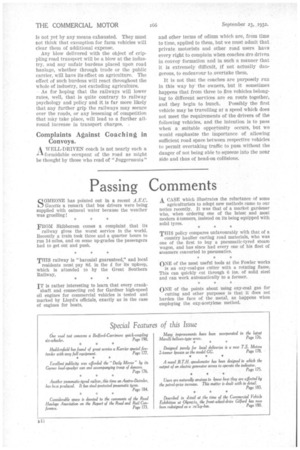Passing Comments
Page 36

Page 37

If you've noticed an error in this article please click here to report it so we can fix it.
SOMEONE has pointed out in a recent A.E.C. Gazette a remark that bus drivers were being supplied with oatmeal water because the weather was gruelling!
FROM SlEibbereen comes a complaintthat its railway gives the worst service in the world. Recently a train took three and a quarter hours to run 14 miles, and on some up-grades the passengers had to get out and push.
THIS railway is "baronial guaranteed," and local residents must pay 8d. in the £ for its upkeep, which is attended to by the Great Southern Railway, IT is rather interesting to learn that every crank shaft and connecting rod for Gardner high-speed oil engines for commercial vehicles is tested and marked by Lloyd's officials, exactly as in the case of engines for boats. A CASE which illustrates the reluctance of some agriculturists to adopt new methods came to our notice recently. It was that of a market gardener who, when ordering one of the latest and most modern 4-tonners, insisted on its being equipped with solid tyres.
THIS policy compares unfavourably with that of a country haulier carting road materials, who was one of the first to buy a pneumatic-tyred steam wagon, and has since had every one of his fleet of steamers converted to pneumatics.
ONE of the most useful tools at the Fowler works is an oxy-coal-gas cutter with a rotating flame. This can quickly cut through 6 ins, of solid steel and can work automatically to a former.
ONE of the points about using oxy-coal gas for cutting and other purposes is that it does not harden the face of. the metal, as happens when employing the oxy-acetylene methoth SIGNIFICANT statements regarding the recom mendations of the Salter Conference are contained in a recent issue of The Accountant. One is as follows: "To impose restrictions on one type or carrier to the material advantage of another, to aid the -railways at the cost of injuring road transport concerns—these are dangers against which the community should be guarded."
A MOBILE policeman was allocated to a certain stretch of main road, and of this the drivers had early news. At midnight, in a roadside café, the policeman was preserit in mufti. The challenge was therefore given out as to which was the fastest lorry, the "race" being timed for 3.30 a.m. Cheerfully braving the driving rain, the constable appeared at the rendezvous, and as the vehicles passed him at about 15 m.p.h. each driver wished him a very good morning. • 'WHEREAS most dust-bin handles are located more than halfway up the bins, the handles of the standard Huddersfield bins are mounted low, their upper edges being only 1 ft. from the ground, whilst the bins are 2 ft. high. This position is found more convenient in respect of lifting, shouldering and tipping, and it might well be emulated.
ALREADY we are hearing from ancillary users that the extra taxation may compel them to turn to rail transport, a course which, however, they view with alarm and dread. The railways, they say, are no more efficient to-day than they were before the war, OPERATORS of public-service vehicles—and, for that matter, goods carriers—sometimes approach us with problems of average speed over regular and well-defined jourueys, In cases where readers are in difficulty It is almost invariably found that the number of stops to be made on the journey is high.
TRAFFIC managers are often puzzled and inclined to disbelieve reports from their drivers. There are two guiding principles which should be borne in mind in connection with average speed. One s that, generally speaking, to keep moving has more effect upon the average than the attainment of high maximum speeds. The other is that, putting the matter non-technically, to lower one's average for a short distance necessitates travelling faster for a longer distance in order to preserve the overall figure.
WE recently had an opportunity of inspecting the tests to which the National Physical Laboratory subject Specimens of stone to discover its suitability for road material. The specimens are first ground accurately to the shape of a cylinder about one inch in diameter, they are then subjected to various abrasive and impact tests, each being carried out for a definite time and the losses of the failures recorded. The binding properties of the material are also tested by forming a paste with powdered stone and water, moulding a test-piece under pressure and heat, and ascertaining its resistance to impact in a similar manner to the original stone.






































































































